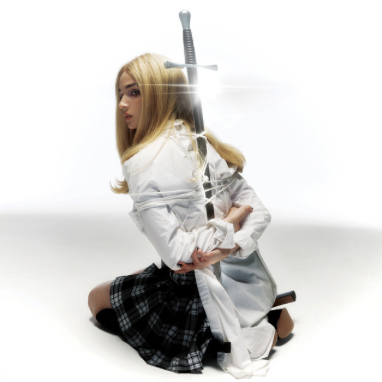Ever since Poppy first made her presence known on the internet, she has been known for poking fun at its culture and being critical of current events and modern issues. She is opinionated and unapologetic, and while this character first spawned in the short-form surrealist videos she would post on her YouTube channel, it eventually progressed into an emotional music career that has spanned many moods, themes, genres and topics.
Her fifth album, titled “Zig,” sees her move away from the rock influences of her previous two albums in favor of visceral, aggressive industrial dance-pop tracks with a hint of metal and screamo influence. There are a variety of criticisms of modern cultural themes such as religion and politics presented in this album as well that complement the abrasive sound being consistently pushed throughout the LP.
The first track on the album, titled “Church Outfit” is textured with aggressive, pounding drums and grinding industrial instrumentation accompanied by a cadence and set of lyrics that sound as though Poppy is quite literally on a warpath that will end in her victory or her demise. This is the most obvious presentation of this theme out of any of the tracks on this album, but it vaguely crops up at various moments throughout the soundscape.
The third track, “Hard,” was a favorite due to the extremely distorted guitar sound that can almost be mistaken for a synthesizer with a high resonance filter on it as well as the various creative instrumentation choices throughout the track’s runtime. A standout moment on this song would have to be the screamo verse toward its back half and the explosion of loud instrumentation that comes with it.
“What It Becomes” and “Flicker,” the album’s fourth and fifth tracks, are both strangely beautiful. There is an omnipresent industrial influence throughout this album, but these two songs also had segments of very flowy vocals and classical composition that meshed well with abstract percussion in a unique fashion.
“1s + 0s,” the sixth track, features a phenomenal guitar solo towards the end of the record with a tone and playing style that does not often cross paths with pop and dance music; this is more proof of Poppy’s interest in creating something monumental and new for her listeners as well as herself.
“Linger,” the eighth track on the album, starts with an acoustic guitar riff that feels similar to Metallica, but the beat drop combines this element with percussion and bass that is undeniably influenced by early electronic artists such as Burial. A pleasant surprise was the heavy drum and bass influence on “The Attic,” the album’s ninth track. The frantic style of percussion meshes with the factory-esque style well, but there are piano chords consistently present throughout the background of this song that give it a strangely emotional vibe.
“Motorbike,” one of the more popular tracks of the album, has a more conventional dance-pop drum beat and some retro-sounding synths with a cool flow to the chorus that jumps from one thought to another at a rapid pace, but it did not hit as hard as some of the previous tracks. As is the norm with most well-crafted albums, “Prove It,” the final track on the record, is wildly different from the rest of the project. It is incredibly bipolar, moving from emotional vocals and piano chords to a significantly faster chorus with vocoded and harsh singing similar to underground hyperpunk tracks. Poppy also pulls a page from Pink Floyd’s book at the end of this track, using the outro to blend into the intro song, “Church Outfit,” to make the album feel like a perfect loop. This was a perfect example of tasteful experimentation morphing into a beautiful and chaotic work of art, a great way to end a great project.
Poppy’s complete willingness to make something completely new every time she walks into the studio is inspirational to artists. This album is for anyone looking to hear something they have never heard before, specifically those who are interested in industrial and metal music. Poppy is one of many artists encouraging change in the modern era of music, and it is through inspirations like her that the next generation of artists will be able to change the way we go about raising the bar through experimentation.
